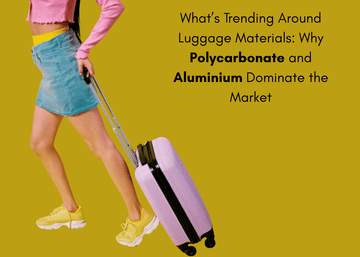Why Are Travellers Rethinking What Their Luggage Is Made Of?
Frequent flyers and weekend explorers are asking a new kind of question these days not about destinations, but about durability. Luggage design used to be all about size or brand. Now, the spotlight has shifted to what’s under the surface: the actual material. Whether you're weaving through a busy terminal or lifting a carry-on into the overhead bin, choosing between polycarbonate luggage and aluminium luggage can genuinely impact your journey.
The Evolution of Luggage: From Fabric to Futureproof
Early luggage was all leather and weight, made for railcars and porters not for budget airlines or 23kg checked limits. Fast forward to the 2020s, and we’re seeing an evolution from fabric-based cases to structured, impact-resistant shells that meet airline regulations and consumer expectations alike.
Today, most carry-on and checked luggage use hardshell materials. And two of them polycarbonate and aluminium have risen as the front-runners in durability, design, and global demand.
Meet the Materials: Aluminium vs Polycarbonate
Here's a look at how the two dominant materials stack up against each other:
|
Feature |
Polycarbonate Suitcase |
Aluminium Suitcase |
|
Weight |
Lightweight (1.5–3.5kg for carry-ons) |
Heavier (2.8–5kg for carry-ons) |
|
Impact Resistance |
High bends without breaking |
Medium—may dent but holds structure |
|
Scratch Resistance |
Moderate—surface scuffs over time |
Low—scratches and dents easily |
|
Security |
Good—TSA locks compatible |
Excellent—metal latches and double locks |
|
Aesthetic |
Sleek, glossy or matte colours |
Premium, metallic finish with prestige appeal |
|
Price Range (INR) |
₹8,000 – ₹20,000 (Mid to Premium) |
₹20,000 – ₹60,000+ (Luxury tier) |
|
Best For |
Regular solo and business travel |
Frequent flyers, long-haul trips, or premium gifting |
Why Polycarbonate Luggage Has Become a Fan Favourite
Polycarbonate is a type of thermoplastic known for being extremely impact-resistant, flexible, and lightweight. That combination makes it a go-to for travellers who value mobility without compromising on strength.
-
Airline-Approved Weight: Most polycarbonate cabin bags clock in under 3kg, keeping you under carry-on limits even when fully packed.
-
Weather Toughness: Unlike fabric bags, it resists rain and surface scuffs during transfers.
-
Budget to Premium Options: Available across a wide price range ideal for first-time solo travellers and regular commuters alike.
With flexible curves and a variety of finishes, polycarbonate luggage adapts to almost any travel style, from budget city breaks to luxury retreats.
Why Some Still Swear by Aluminium Luggage
There’s no denying the visual statement of aluminium suitcases they exude old-money minimalism and high-end reliability. But that’s not all they offer:
-
Unmatched Security: Aluminium suitcases often feature latches instead of zippers, which reduces risk of tampering.
-
Durability Under Pressure: They hold form even under stacked weight or rough handling at airports.
-
Longevity: Many come with 10-year warranties due to their metal construction and resilience.
Yes, they may dent, but dents become part of the aesthetic, each one a badge of a journey well-travelled.
When to Choose Which: Travel Profiles That Fit
Every material has a moment. Here's when each shines:
-
Choose Polycarbonate if:
You’re looking for a lightweight, airline-compliant suitcase that’s easy to manoeuvre and suitable for regular or occasional travel. It’s perfect for solo trips, business meetings, or regional getaways. -
Choose Aluminium if:
You’re a frequent international traveller, carrying valuables, or simply prefer elevated aesthetics. It’s a worthy investment for professionals or creatives who travel with gear.
How to Decide: Your Personal Luggage Durability Checklist
Before choosing a suitcase, ask yourself:
-
What type of travel do I do most short or long haul?
-
Am I carrying fragile tech or documents?
-
Do I want something lightweight or long-lasting (or both)?
-
What matters more to me looks, longevity, or storage?
Your answers will point you toward the best luggage material for your needs, not just what's trending on the shelf.
The Bigger Picture: Sustainability and Smart Features
As eco-conscious travel gains ground, luggage brands are exploring hybrid polycarbonate reinforced with rPET (recycled plastic) or aluminium casings with bio-resin linings. Add in smart features like GPS trackers, weight sensors, and anti-theft tech, and it’s clear the future of luggage isn’t just hard or soft, it's intelligent.
EUME: Designed for Travellers Who Don’t Compromise
For travellers who want performance without the bulk, EUME’s luggage collection combines the best of both material worlds. Their premium hard-shell cabin bags integrate polycarbonate durability with clean lines, ergonomic handles, and smooth spinner wheels designed for solo travellers and frequent flyers alike.
What sets EUME apart is its human-first design approach: lightweight frames, and weatherproof finishes all wrapped into luggage that’s made to last without weighing you down. Whether you’re chasing meetings or sunsets, EUME delivers function with polish.
Final Thoughts:
Choosing between aluminium vs polycarbonate is less about one being “better” and more about how you travel. A short-haul city hopper might crave the lightweight agility of polycarbonate luggage, while a frequent flyer with precious contents might opt for a more secure aluminium suitcase.
What matters most is choosing luggage for travel that aligns with your pace, needs, and future plans.
And for those who want all the tech, toughness, and style without unnecessary weight, EUME’s luggage range proves you don’t have to compromise. With curated materials and travel-first features, their designs represent the next step in solo and smart travel.
FAQs
What is the difference between aluminium and polycarbonate luggage?
Aluminium luggage is rigid, dent-resistant, and highly secure with metal latches, making it ideal for business or international travel. Polycarbonate luggage, by contrast, is lighter and more flexible, perfect for short trips or solo travel where mobility matters.
Which is more durable: aluminium or polycarbonate?
In terms of sheer strength, aluminium luggage lasts longer structurally. However, polycarbonate luggage absorbs shocks better, which makes it ideal if you’re constantly moving or handling your bag yourself like on local flights or weekend hops.
Are aluminium suitcases worth the price?
Yes, especially if you travel with valuables or need long-term protection. An aluminium suitcase offers unmatched strength and aesthetic value ideal for photographers, consultants, or executives carrying important equipment.
What is the best material for carry-on luggage?
Polycarbonate luggage is widely considered the best for carry-ons due to its low weight, cabin-compliant size, and impact resistance. It’s perfect for solo flyers and those looking to avoid check-in queues.
Are hardshell suitcases better than softside?
Yes, particularly if you prioritise protection and structure. Hardshells made from polycarbonate or aluminium prevent crushing and are easier to clean, especially useful for international or wet-weather travel.
Which luggage material is best for checked bags?
For checked bags, aluminium luggage is more reliable due to its strength and secure locking. It’s ideal for long-haul travel where your bag faces rough handling in cargo.
How do I choose luggage material?
Start with your travel frequency, then assess if you value weight, looks, or durability. A luggage material comparison helps identify if polycarbonate luggage fits your style or if aluminium offers more peace of mind.
What are the pros and cons of each?
Aluminium is sleek, secure, and long-lasting but adds weight and shows surface marks. Polycarbonate is light, flexible, and often cheaper, but can wear out sooner under extreme use. Think of aluminium for checked protection, polycarbonate for agile carry-ons.























